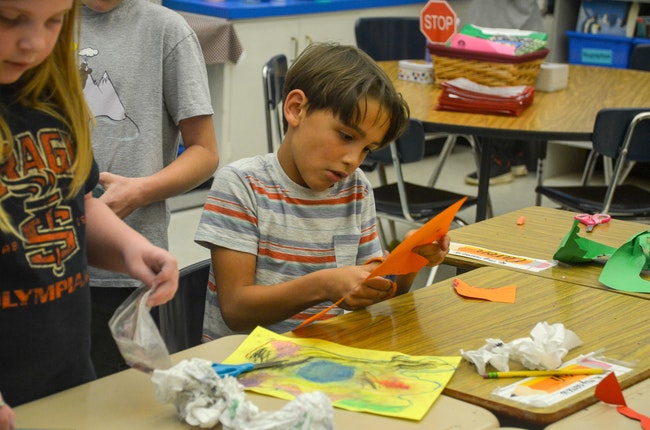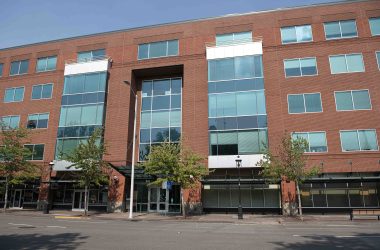 Third-grade student Levi Black cuts out a shape during an art lesson at Salem Heights Elementary School on Oct. 18, 2019 (Rachel Alexander/Salem Reporter)
Third-grade student Levi Black cuts out a shape during an art lesson at Salem Heights Elementary School on Oct. 18, 2019 (Rachel Alexander/Salem Reporter)
Third-grade students in a Salem Heights Elementary classroom listened eagerly as Laura Mack explained their task.
After discussing the feelings evoked by different colors, the students took construction paper, outlined a shape in oil pastel, cut it out and drew on it. Then, they put their shapes together on the black fabric sitting on the classroom rug.
“It’s going to make one huge crazy batch of color,” Mack told them.
Mack, a Chemeketa Community College art instructor, is among local artists who have donated their time to bring art lessons into three Salem elementary schools a few times a year.
[Help build Salem Reporter and local news – SUBSCRIBE ]
The lessons go beyond making Santa Claus or a Thanksgiving turkey out of construction paper. Mack’s goal is art literacy: teaching kids, whatever their age, to understand the creative process and how people across time and cultures have responded to their world in visual ways.
“The range of human expression: how do people make meaning in the world? It’s about the human experience,” she said.
Mack and other local artists have long urged the Salem-Keizer School District to bring back regular art lessons back into local schools.
 Laura Mack works with third-graders during an art lesson at Salem Heights Elementary School on Oct. 18, 2019 (Rachel Alexander/Salem Reporter)
Laura Mack works with third-graders during an art lesson at Salem Heights Elementary School on Oct. 18, 2019 (Rachel Alexander/Salem Reporter)
At every elementary school, nearly all class time is devoted to math and reading.
Even social studies and science, considered core subjects in middle and high school, are often confined to an hour or two per week. Teachers rely on readings about topics like the phases of the moon to teach kids scientific concepts while they’re learning to read.
Superintendent Christy Perry said school schedules don’t always give the full measure of what students learn in a given day. Many teachers incorporate other topics into those lessons, creating a hands-on science area in math lessons, for example.
Schools do have a rotating elective time where students get library time, PE and music.
Some teachers use the limited class time not dedicated to reading and math for art projects or incorporate that into lessons.
“There’s places where consistently educators are figuring how to bring art into their literacy and they’re figuring out how to bring science into our math,” Perry said.
But no elementary school has art classes taught as a regular part of the schedule.
“Because the arts have been out of the schools for a number of years, there’s no collective consciousness,” said Kathy Dinges, community arts education director at the Salem Art Association. “There’s a real vacuum of not knowing what they’re missing.”
Now, with Salem-Keizer poised to receive about $35 million in new state funding from the Student Success Act, Mack is renewing the push.
“I’m not trying to get a job and I’m not trying to get more work volunteering. I want them to hire actual art teachers,” she said.
 Third-grade students admire their finished work after an art lesson at Salem Heights Elementary School on Oct. 18, 2019 (Rachel Alexander/Salem Reporter)
Third-grade students admire their finished work after an art lesson at Salem Heights Elementary School on Oct. 18, 2019 (Rachel Alexander/Salem Reporter)
In an education system focused on reading and math standards, it’s easy for art to be shunted aside. But Mack sees art as a way for kids to learn critical skills that translate to more academic subjects: the fine motor control needed to draw with oil pastels, the confidence to try something that may not work and know it’s okay.
“That piece of creativity – being uncomfortable in the uncomfortable area – is crucial. It’s risk-taking,” she said.
A good art lesson is about showing students many ways to solve a problem or approach a task, she said.
Those skills are mainstays across local elementary schools. Many teachers and principals talk about a “growth mindset,” teaching students that it’s okay to not understand something yet, and that they can learn if they apply themselves.
Mack said art is an ideal place to learn those skills and engage kids who struggle in other areas.
“For students who are having trouble academically, having a reason to come to school besides reading, math, writing is crucial,” she said.
Research backs her up. A 2019 study about an arts access program in Houston schools found students who got an arts education were less likely to have a discipline referral. They improved their writing skills and compassion for others.
Other studies have shown students retain math and reading lessons better when art is incorporated, and that art lessons can improve student attendance.
Though Mack’s Salem Heights lesson was on a Friday afternoon, students were focused and engaged.
 Thomas Daffron draws an abstract heart and mountain during an art lesson in his third grade class at Salem Heights Elementary School (Rachel Alexander/Salem Reporter)
Thomas Daffron draws an abstract heart and mountain during an art lesson in his third grade class at Salem Heights Elementary School (Rachel Alexander/Salem Reporter)
Thomas Daffron drew a heart-shaped line on a green sheet of construction paper, then outlined a larger shape to the right. He said the heart was being guarded by a mountain to protect it from evil creatures on the other side.
“If the creature gets it, the whole world ends,” he said.
As students finished their shapes, they gathered on the class rug to put them together, eager to show off their work and see how it fit into the whole.
Daffron said he enjoys art classes and was surprised to learn many Salem students don’t have them regularly.
Parents and teachers at Salem Heights said they see clear benefits for students from art literacy lessons even though they only happen three times a year.
Charlotte Lysne, the third-grade teacher whose class Mack was teaching, said the classes help her see students in a new light.
“For those students who do not find a creative outlet through writing or other academic tasks,” art lessons give them another way to be creative, she said in an email.
She thinks it’s important for teachers to integrate art into class, but said having a knowledgeable artist teaching makes her more confident doing so, because Mack can talk about things like color theory and present work from professional artists.
Hanna McCullough, a parent volunteer, said she’s seen the impact even infrequent lessons have on the whole school.
“They all look forward to it so much,” she said.
 Parent volunteer Hanna McCullough passes out construction paper during an art lesson at Salem Heights Elementary School (Rachel Alexander/Salem Reporter)
Parent volunteer Hanna McCullough passes out construction paper during an art lesson at Salem Heights Elementary School (Rachel Alexander/Salem Reporter)
She’s heard students refer to the works of professional artists or talk about what they created months or years after the fact, and said the lessons give kids confidence that carries over into other parts of school.
“When you see them later on, they can still tell you about the art they learned,” she said.
But with no elementary school art teachers in the Salem-Keizer district, lessons like these can be limited by who can pay.
The art literacy program is only at Salem Heights, Schirle and Candalaria elementary schools: all south Salem schools with active parent clubs that raised $500 to $1,000 a year for supplies. In a district where seven in 10 students qualify for free lunch, many schools do without such support.
Perry agreed art is important, and said she sees value in lessons like Mack’s.
She said she sees evidence of elementary teachers incorporating art, including in schools with much higher poverty rates.
At Eyre Elementary, one teacher who has done clay projects with students multiple times, she said. If one teacher in a building has an interest in art, they often share lessons with other classrooms.
As with many demands in education, Perry said time is the biggest barrier. Using some of the new state money to extend the school day would give teachers more options to add art, science and other topics into the elementary day.
“Best practice is a 90-minute block of time for literacy and a 90-minute block of time for math and when you look at our performance, we have to have that,” Perry said.
 Third grade students admire a collage of shapes made during an afternoon art lesson on Oct. 18, 2019 (Rachel Alexander/Salem Reporter)
Third grade students admire a collage of shapes made during an afternoon art lesson on Oct. 18, 2019 (Rachel Alexander/Salem Reporter)
Perry is relying on a task force of district staff and community leaders to give her recommendations on how best to spend the state funding.
That money is supposed to be used to serve students who persistently perform below their grade level and have lower graduation rates. Perry is focusing on students with disabilities, black and Pacific Islander students, non-native English speakers, low-income students and students who are homeless or in foster care.
State guidelines give district leaders flexibility on how to best achieve their goals. Money can be spent on a “well-rounded education,” a category that includes more help with reading in early elementary school or more classes like art, music, PE, science and technology.
The Salem Art Association has a program to bring artists into schools to teach hour-long lessons that incorporate reading or math standards. Schools must pay $45 per lesson, plus supply materials and reimburse the artist for transportation.
Over the years, Dinges said that program has worked in many local schools including Four Corners, which received a grant for art lessons.
The art association is now hiring a school program coordinator who will look at creative ways to get art lessons into more local schools.
But Dinges agrees that infrequent hour-long lessons can only do so much.
“If you had a mathematician coming to the classroom for an hour a year, how much would you learn?” she said.
Reporter Rachel Alexander: [email protected] or 503-575-1241.

Rachel Alexander is Salem Reporter’s managing editor. She joined Salem Reporter when it was founded in 2018 and covers city news, education, nonprofits and a little bit of everything else. She’s been a journalist in Oregon and Washington for a decade. Outside of work, she’s a skater and board member with Salem’s Cherry City Roller Derby and can often be found with her nose buried in a book.









